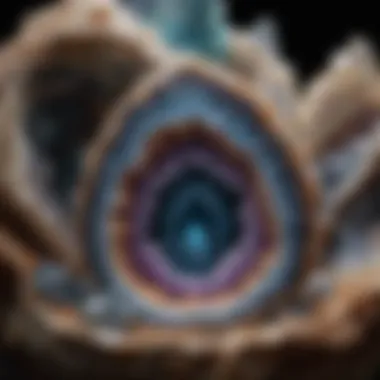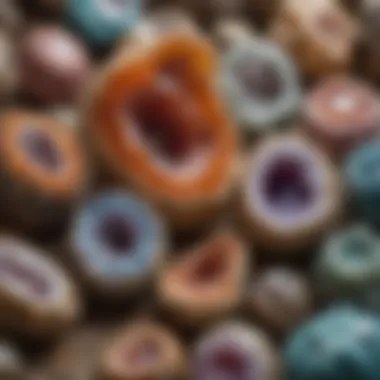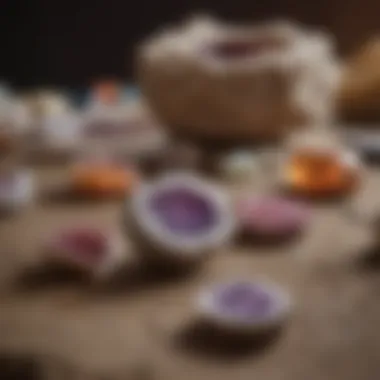Geode Cracking Techniques for Collectors: A Deep Dive


Intro
Exploring the world of geode cracking opens up an exciting realm for collectors, merging geology with a touch of creativity. What once may seem like a mundane rock can blossom into a treasure chest of sparkling crystals, giving enthusiasts a thrill like no other. As we embark on this journey, we’ll unearth the techniques, tools, and insights needed to not only crack open these fascinating formations but also appreciate their beauty and history.
Geodes, often formed from volcanic or sedimentary processes, house gorgeous mineral formations within their hard, outer shells. For those who collect these natural wonders, understanding the history and origins of geodes is crucial. This understanding enhances the appreciation of every specimen cracked open, revealing insights about the Earth’s geological past.
In this article, we will delve deeper—unraveling methods of selecting the right geodes, familiarizing ourselves with various types, and discussing safety measures every collector should keep in mind. From the moment you lay eyes on a geode to the joyous moment of cracking it open, the entire process is an art form intertwined with scientific knowledge.
History and Origins
The story of geodes is not just about rocks; it weaves through the tapestry of human interest in natural history. Collecting hasn't always been an organized hobby; it’s rooted in curiosity that spans centuries.
Overview of Collectibles, Rocks, and Fossils
Historically, a fascination with geodes and similar collectibles can be traced back to early geological studies, when explorers would gather samples to understand Earth's composition. Over time, rocks, fossils, and minerals became coveted objects not merely for their aesthetic but also for their scientific value. This passion continues today, bridging the gap between collecting and education.
Historical Significance and Cultural Impact
Many cultures have placed symbolic meanings on geodes. In ancient civilizations, they were often associated with protection and healing. For example, in Japan, certain geodes were revered as talismans. Rich in history, each geode tells a story—whether it's through the tale of its formation over millions of years or the hands it has passed through.
The cultural impact of geodes extends into modern times as well, where they appear in art, jewelry, and even home decor. Stone collectors often speak about the thrill of unearthing something rare, transforming what may have started as a hobby into an intellectual pursuit.
Geology enthusiasts and collectors alike find value in cracking geodes, not just for the beauty inside but as a connection to the Earth and its history. Understanding this context adds significant depth to the practice of geode cracking, making it more than just a task—it's a journey filled with discovery and appreciation.
Identification and Classification
Moving deeper, one must learn to identify and classify different types of geodes, as this knowledge will guide collectors in selecting the most promising specimens.
Guide to Identifying Rocks and Fossils
When sifting through potential geodes, look for certain characteristics:
- Shape: Typically spherical or oblong, a good geode often has a somewhat irregular surface.
- Weight: Genuine geodes may feel heavy for their size due to their mineral-rich interiors.
- Texture: A rough, rocky exterior often suggests something beautiful lies inside.
Common Types and Variations
Geodes can vary widely, and knowing the common types will assist collectors in honing their searching skills. Examples include but aren't limited to:
- Amethyst Geodes: Renowned for their purple crystals, beloved by many collectors.
- Calcite Geodes: These often display clear or white interiors, sometimes even fluorescent properties.
- Agate Geodes: Known for their layered appearance, offering a stunning visual experience.
Each type holds its own unique charm and value, drawing collectors closer to the rich narrative embedded in the rocks.
As we journey through the remainder of this article, we’ll look at the techniques for cracking geodes, safety precautions to keep in mind, and how to care for your precious finds after revealing their secrets.
Preface to Geodes
Geodes are a captivating aspect of Earth’s geological artistry. This section provides a foundation for understanding why geodes hold such fascination for collectors. It's not just about their exterior ruggedness; beneath that hard shell lies an intricate display of nature’s design. The allure of cracking open a geode to reveal the vibrant crystals inside is a thrill that many rock and fossil enthusiasts seek.
What Are Geodes?


In simple terms, geodes are hollow rock formations that are typically filled with crystals or secondary mineral deposits. They are formed not in one fell swoop but over a lengthy period. Geodes can be found in sedimentary, volcanic, or metamorphic rocks; each type offers something unique. Their exterior appearance can be deceiving, often resembling nothing more than a nondescript pebble. For those who understand, however, the real treasure is buried under that seemingly mundane rock surface.
Formation Process
The formation of geodes is a slow and nuanced process that begins with gas bubbles trapped in volcanic rocks or sediment. Over thousands—sometimes millions—of years, mineral-laden water seeps into these voids. As this water evaporates, the minerals crystallize, filling the cavity over time. The types of minerals that form can vary widely, contributing to the diversity in geode interiors. From sparkling quartz to vibrant amethyst, the variety is astounding, making each extraction a new discovery.
"The crystal growth inside geodes is nature’s way of crafting beauty over time—an art form that costs nothing but patience."
Types of Geodes and Their Features
Collectors often find themselves drawn to particular types of geodes based on personal taste and collection goals. Here’s a quick rundown of some prominent types:
- Quartz Geodes: Known for their clear and striking crystals, quartz geodes are popular among collectors for their clarity and brilliance.
- Amethyst Geodes: These geodes are filled with purple quartz crystals and are often highly sought after for their vibrant color.
- Calcite Geodes: Characterized by their creamy hues, calcite geodes can surprise with their stunning and intricate crystal formations.
- Agate Geodes: These are known for their colorful bands and intricate patterns, making them visually stunning.
Understanding these types not only enriches the collector's knowledge but also assists in recognizing quality and value in potential finds. Each geode is a world unto itself, a tangible connection to Earth's natural history.
Essential Tools for Geode Cracking
When it comes to cracking geodes, having the right tools can make all the difference. Like a painter needs brushes, collectors need their tools to expose the hidden beauty within these rocky treasures. Using proper equipment isn’t just about convenience; it can dramatically enhance safety and ensure that the geodes are cracked in a way that maximizes their aesthetic value.
Each tool serves a specific purpose, catering to the varying techniques and preferences among collectors. With a proper toolkit, one can take control of the often unpredictable nature of geode cracking and navigate through the process with greater expertise.
Geode Cracker: Overview
A geode cracker is a specialized tool designed for splitting geodes effectively. This tool typically features two robust handles connected to a sturdy frame, allowing you to apply consistent pressure to the geode. The construction of a geode cracker is fundamental; a poorly made tool can result in splintering or even shattering the specimen, ruining its potential beauty.
While some collectors opt for makeshift solutions, investing in a dedicated geode cracker is advisable for serious enthusiasts. It’s not merely about cracking; it’s a matter of precision. Using a high-quality geode cracker ensures that the split occurs along desirable lines, leaving much of the outer surface intact and offering a clean view of the interior crystals.
Moreover, different models have varying degrees of pressure capability. Some may even feature adjustable blades to cater to different sizes and types of geodes. When selecting a geode cracker, a collector should consider the size of the geodes they intend to crack, along with their own strength and comfort with the tool.
Other Useful Tools
Beyond the geode cracker itself, a few other tools can aid in the process, enhancing both safety and effectiveness. Here’s a roundup of helpful items:
- Safety Goggles: Protecting the eyes is crucial, as cracking a geode can send tiny fragments flying, potentially causing injury.
- Gloves: A pair of durable gloves can provide grip and protect hands from sharp edges and debris.
- Hammer: A simple hammer can be effective for smaller geodes or for making initial taps to test the integrity of cracks.
- Chisel: Chisels can be used alongside a hammer to make more precise breaks, especially on stubborn geodes.
- Measuring Tape: Knowing the dimensions helps in selecting geodes that are manageable.
- Marker: A simple marker can be used to mark weak spots on the geode’s surface, providing guidance during the cracking process.
Techniques for Cracking Geodes
Understanding effective techniques for cracking geodes is key for any collector eager to unlock their hidden treasures. The process can seem daunting, yet with the right methods, it transforms into a rewarding adventure. The approach taken not only influences the quality of your reveals but also ensures the longevity and preservation of the specimen. Proper technique maximizes the potential for stunning crystals to be uncovered while minimizing risks of damage.
Methods of Cracking
When it comes to cracking geodes, there are several methods to consider, each with its own set of advantages and disadvantages.
- Manual Cracking: Using a geode cracker or a hammer, this method involves strategically striking the geode in a manner that can maximize shell breakage while protecting internal crystals.
- Wedge Method: This involves inserting a wedge into a small crack in the geode, widening it by hammering the wedge.
- Freezing Method: By placing the geode in the freezer for a few hours, the rapid temperature change can help to weaken the internal bonds.
- Water Method: Submerging the geode in water over time can also weaken its structure, making it easier to crack.
- Pros: Immediate feedback; cost-efficient if using common tools; can be done anywhere.
- Cons: Requires practice to master; risk of injury or damaging the geode.
- Pros: More control over cracking direction; reduces chances of shattering.
- Cons: Requires an initial opening; may need specially designed wedges.
- Pros: Minimal risk of injury; preserves the crystal integrity.
- Cons: Requires patience; does not always guarantee a successful split.


- Pros: Natural approach with little effort.
- Cons: Time-consuming, and results may vary.
Knowing these methods encourages collectors to experiment and discover which technique works best for their specific geode types.
Identifying the Best Spots to Crack
Finding the optimal locations on a geode to crack requires keen observation and a bit of intuition. Generally, the best spots to attempt a crack are:
- Natural Cracks and Imperfections: Look for existing fissures, as they’re usually weaker and easier to break.
- Round Edges: The sides, often rounded, can provide leverage for cracking without sending shards flying.
- Color Patterns: Where differences in mineral content create visible stratifications may guide your efforts—this can hint at potential internal beauty.
Tip: Always give the geode a good inspection by turning it in the light; reflective surfaces can help spot any weak points. The understanding here is that knowing where to apply force significantly increases your chances of achieving a clean and satisfying break.
"The right technique can turn what could’ve been a simple break into a careful reveal of nature’s art."
By honing in on these techniques, collectors can not only enjoy the process but also deepen their appreciation for the marvels hidden within geodes.
Safety Precautions
Engaging in the art of geode cracking can be an exciting pursuit for collectors, but overlooking safety precautions can turn a fascinating hobby into a hazardous adventure. Being mindful of safety is paramount, as the process involves tools and materials that can be harmful if not handled properly. The right precautions don’t just protect physical well-being; they also ensure an enjoyable experience. Understanding how to create a safe environment, and knowing which protective gear to use, greatly minimizes risks associated with geode cracking.
Protective Gear
When it comes to cracking geodes, dressing the part is not just about aesthetics. Proper protective gear is essential to safeguard against potential injuries. At the very least, one should consider the following items:
- Safety Goggles: Protecting your eyes might seem like a no-brainer, but many collectors underestimate how easily flying debris can occur during the cracking process. Wearing safety goggles shields your eyes from small chips and shards that could cause serious injuries.
- Gloves: Donning a sturdy pair of gloves can keep your hands safe from sharp edges and rough surfaces. It’s better to work with gloves that offer a good grip while also being puncture-resistant. For instance, heavy-duty leather or synthetic gloves can do the trick.
- Dust Mask: When geodes are cracked open, dust and tiny particles are often released into the air. A dust mask can help prevent inhalation of unwanted particles that could irritate your respiratory system.
- Steel-Toed Boots: Consider wearing steel-toed boots when working with heavy tools and large geodes. This footwear not only protects your feet from falling objects, but also enhances stability and support.
Approaching geode cracking as one would a serious outdoor project reflects a keen understanding of its risks. It’s wise to set aside an area dedicated to this task, ensuring all necessary protective gear is easily accessible.
Safe Workspace Setup
Creating a workspace that prioritizes safety is just as crucial as using the right gear. When finding the perfect spot, consider the following:
- Choose a Solid Surface: A sturdy, flat surface ensures stability while cracking geodes. Avoid working on uneven ground or makeshift tables. A workbench or a heavy-duty table will serve best.
- Clear the Area: Remove any clutter and distractions that might cause accidental injuries. A clean workspace not only promotes focus but also minimizes tripping hazards.
- Good Lighting: Ensure adequate lighting facilities. Clear visibility is essential for identifying weak spots in the geodes and reducing the chances of missteps with tools.
- Organize Your Tools: Prioritize organization by having a dedicated area for your tools. Keeping them orderly and within reach reduces the need to search for what you need, saving time and maintaining your focus.
- Emergency Kit: It’s smart to have an emergency kit on hand, stocked with basic first aid supplies like bandages, antiseptic wipes, and ice packs. Although you hope to never need it, being prepared speaks volumes about your commitment to safety.
Creating a safe workspace coupled with the right protective gear not only reduces the risk of injury but also enhances the overall experience of geode cracking. Keeping safety at the forefront allows you to fully appreciate the art and science behind this fascinating endeavor.
"Safety is not a gadget, but a state of mind."
With these precautions firmly in place, geode cracking can be a rewarding adventure, allowing you to delve deeper into the wonders of the natural world.
Post-Cracking Care
After the excitement of cracking open a geode, the real work begins. Proper post-cracking care is not just a final step, but a crucial part of the entire geode collecting experience. It involves more than simply showcasing your new treasure; it ensures that your painstakingly revealed inner beauty remains intact and vibrant. Without the right care, the gem can lose its luster, and cracks might not hold up over time.
The benefits of good post-cracking practices are manifold. First, it protects the delicate minerals and crystals inside from dust and potential damage. Not only that, it ensures that the geode retains its structural integrity, which can be problematic if the pieces are not carefully cleaned or displayed. Therefore, it’s important to approach this stage with the same care you exhibited when selecting and opening the geode.
Cleaning and Preservation Techniques
Cleaning your cracked geode is essential for removing dust, dirt, and any residues left from the cracking process. Start by rinsing it gently under lukewarm water. Avoid hot water, as it can shock the minerals and cause cracking. Use a soft brush, like a toothbrush, to gently scrub the surfaces to remove grit without scratching.


For more stubborn dirt, a solution of mild soap and water can be utilized. After cleaning, rinse thoroughly to ensure no soap is left behind, as it can create a film that dulls the sparkle of the crystals. It’s also advisable to dry your geode slowly and completely before displaying it to prevent moisture buildup that could lead to mold.
When it comes to preserving your finds, there are a few methods worth considering:
- Clear Acrylic Coatings: These can be applied to enhance the appearance and protect against scratches.
- Natural Oils: A light application of mineral oil can help in maintaining the shine, but don’t overdo it; a little goes a long way.
It's also wise to store the geodes in a stable environment to minimize temperature changes that can cause the minerals to expand and contract.
Displaying Your Cracked Geodes
After you’ve cleaned and cared for your geodes, the next step is to think about how to display them. A well-thought-out display not only beautifies your space but also showcases the work you’ve put into selecting and cracking these treasures.
Consider these ideas when displaying your cracked geodes:
- Shadow Boxes: These allow for a 3D arrangement that draws the eye.
- Glass Terrariums: They create a mini-ecosystem that protects the geodes while presenting them beautifully.
- Natural Wood Stands: Incorporating natural materials can enhance the earthy aesthetic of your pieces.
Additionally, labeling your geodes can add educational value to your display. Include information like the type of geode, where it was found, and details about the cracking process. This can encourage thoughtful discussions with visitors and fellow collectors.
"Geodes are not just rocks; they are stories waiting to be told."
The Value of Cracked Geodes in Collectibles
Cracked geodes hold a unique position in the realm of collectibles, appealing to enthusiasts for their geological significance, aesthetic beauty, and potential monetary value. Collectors are drawn not only by the appearance of these geodes but also by the story they tell about our planet’s geological history. Once cracked open, these rock formations reveal stunning crystals and mineral compositions that were hidden from view. This section examines the importance of understanding market dynamics and how to evaluate your findings effectively.
Market Demand and Trends
Demand for cracked geodes is influenced by several factors, such as their visual appeal and educational value. As more people develop an interest in geology and the natural world, the market for geodes continues to grow. Collectors are regularly on the lookout for unique specimens, especially those with rare mineral combinations or striking colors.
- The rise of online marketplaces has broadened the scope for both buyers and sellers, making it easier for collectors to access a variety of geodes. Websites like Reddit and auction platforms see frequent discussions about geode fascination, helping enthusiasts connect with one another.
- Seasonal trends can also dictate market demand. For instance, during gift-giving occasions, cracked geodes often become popular choices, as they represent a unique gift option for children and adults alike.
- A notable trend is the shift towards ethically sourced and sustainably obtained geodes. This aspect holds appeal for a growing demographic of eco-conscious collectors, which presently shapes purchasing decisions.
When it comes to market trends, one must keep an eye on the movements in collections. For example, influencers on platforms like Facebook often highlight specific types of geodes, skewing interest toward those specimens. Additionally, attendance at gem and mineral shows can signal trends, as collectors showcase their finds and inspire others.
Evaluating the Worth of Your Collection
Determining the worth of your cracked geodes is not a simple task, yet it’s crucial for serious collectors. Valuation depends on several factors, including rarity, appearance, and market demand. Here are some points to consider when evaluating your collection:
- Rarity of Specimens: Geodes that contain unusual minerals or have unique crystalline structures often fetch higher prices. Not all geodes are created equal; understanding which ones are sought after can make a significant difference in value.
- Quality of Interior: The quality of the crystals and coloring on the inside can affect a geode’s price. A geode displaying vibrant hues or flawless specimen interiors tends to attract more interest.
- Historical Significance: Some geodes have provenance linked to geological events or famous locations, making them more desirable. These stories often resonate with potential buyers, creating emotional connections that may enhance their value.
- Market Comparisons: Keeping an eye on sales from reputable sources such as geological institutions or specialized dealers can help you gauge your collection’s worth based on current market trends. Tools like price guides and auction results can provide a benchmark for your evaluation.
Understand that the worth of your geodes can fluctuate over time based on market conditions, much like any collectible item.
By carefully evaluating and monitoring your cracked geodes, you can cultivate a collection that not only holds personal value but can also appreciate over time. Whether you plan to sell or simply admire your collection, understanding its worth is a key aspect of your journey in collecting.
End
As we wrap up our exploration into the intricacies of geode cracking, it's essential to reflect on how this practice intertwines art and science. Not only does cracking geodes reveal their hidden beauty, but it also connects you with a timeless geological process, rich in history and wonder.
Reflecting on the Art and Science of Geode Cracking
The thrilling moment when a geode splits open is not merely a technical endeavor. It's an experience steeped in anticipation. The techniques and tools utilized—be it a specialized geode cracker or simple safety equipment—cannot be overlooked. They offer more than protection; they provide a framework for expressing creativity in how one approaches the craft.
By understanding the geological formation of geodes, collectors gain insight into their value and rarity. The natural patterns and crystalline formations speak to both aesthetic appreciation and scientific curiosity, making this activity deeply rewarding on multiple levels.
Moreover, engaging in this practice fosters a sense of community among collectors. Sharing techniques, showcasing beautiful specimens, and discussing insights around market trends and collectible value solidifies connections within this unique niche. It's not just about the individual geode; it's about the journey shared with fellow enthusiasts.
In essence, delving into geode cracking champions a broader appreciation for the geological wonders of our planet. With every crack, we tap into the earth's story, revealing not just stones but the narratives of time and elemental transformation.
Gathering knowledge from this exploration enhances your collection’s value and enriches your experiences as a collector. In the end, understanding the art and science behind geode cracking will not only equip you with technical skills but also imbue every specimen with a sense of reverence and artistic expression.



